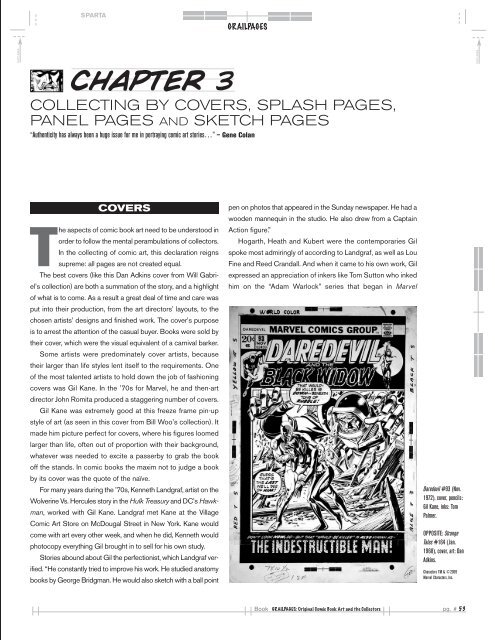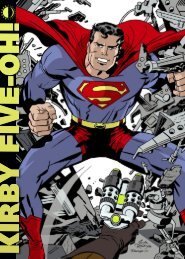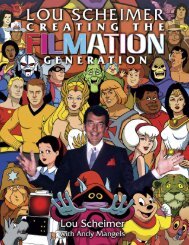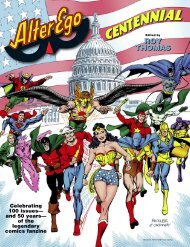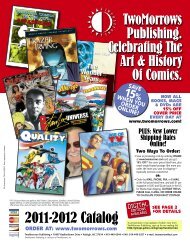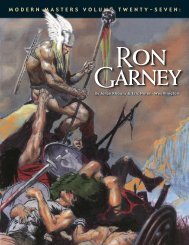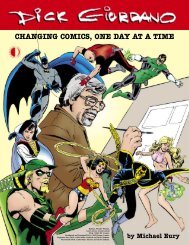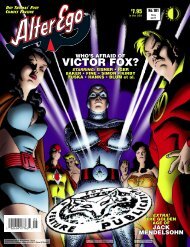Original Comic Book Art And The Collectors - TwoMorrows
Original Comic Book Art And The Collectors - TwoMorrows
Original Comic Book Art And The Collectors - TwoMorrows
You also want an ePaper? Increase the reach of your titles
YUMPU automatically turns print PDFs into web optimized ePapers that Google loves.
COPY AREA<br />
SPARTA<br />
COVERS<br />
<strong>The</strong> aspects of comic book art need to be understood in<br />
order to follow the mental perambulations of collectors.<br />
In the collecting of comic art, this declaration reigns<br />
supreme: all pages are not created equal.<br />
<strong>The</strong> best covers (like this Dan Adkins cover from Will Gabriel’s<br />
collection) are both a summation of the story, and a highlight<br />
of what is to come. As a result a great deal of time and care was<br />
put into their production, from the art directors’ layouts, to the<br />
chosen artists’ designs and finished work. <strong>The</strong> cover’s purpose<br />
is to arrest the attention of the casual buyer. <strong>Book</strong>s were sold by<br />
their cover, which were the visual equivalent of a carnival barker.<br />
Some artists were predominately cover artists, because<br />
their larger than life styles lent itself to the requirements. One<br />
of the most talented artists to hold down the job of fashioning<br />
covers was Gil Kane. In the ’70s for Marvel, he and then-art<br />
director John Romita produced a staggering number of covers.<br />
Gil Kane was extremely good at this freeze frame pin-up<br />
style of art (as seen in this cover from Bill Woo’s collection). It<br />
made him picture perfect for covers, where his figures loomed<br />
larger than life, often out of proportion with their background,<br />
whatever was needed to excite a passerby to grab the book<br />
off the stands. In comic books the maxim not to judge a book<br />
by its cover was the quote of the naïve.<br />
For many years during the ’70s, Kenneth Landgraf, artist on the<br />
Wolverine Vs. Hercules story in the Hulk Treasury and DC’s Hawkman,<br />
worked with Gil Kane. Landgraf met Kane at the Village<br />
<strong>Comic</strong> <strong>Art</strong> Store on McDougal Street in New York. Kane would<br />
come with art every other week, and when he did, Kenneth would<br />
photocopy everything Gil brought in to sell for his own study.<br />
Stories abound about Gil the perfectionist, which Landgraf verified.<br />
“He constantly tried to improve his work. He studied anatomy<br />
books by George Bridgman. He would also sketch with a ball point<br />
GRAILPAGES<br />
CHAPTER 3<br />
COLLECTING BY COVERS, SPLASH PAGES,<br />
PANEL PAGES AND SKETCH PAGES<br />
“Authenticity has always been a huge issue for me in portraying comic art stories…” – Gene Colan<br />
pen on photos that appeared in the Sunday newspaper. He had a<br />
wooden mannequin in the studio. He also drew from a Captain<br />
Action figure.”<br />
Hogarth, Heath and Kubert were the contemporaries Gil<br />
spoke most admiringly of according to Landgraf, as well as Lou<br />
Fine and Reed Crandall. <strong>And</strong> when it came to his own work, Gil<br />
expressed an appreciation of inkers like Tom Sutton who inked<br />
him on the “Adam Warlock” series that began in Marvel<br />
Daredevil #93 (Nov.<br />
1972), cover, pencils:<br />
Gil Kane, inks: Tom<br />
Palmer.<br />
OPPOSITE: Strange<br />
Tales #164 (Jan.<br />
1968), cover, art: Dan<br />
Adkins.<br />
Characters TM & ©2009<br />
Marvel Characters, Inc.<br />
<strong>Book</strong> GRAILPAGES: <strong>Original</strong> <strong>Comic</strong> <strong>Book</strong> <strong>Art</strong> and the <strong>Collectors</strong> pg. # 53<br />
COPY AREA


